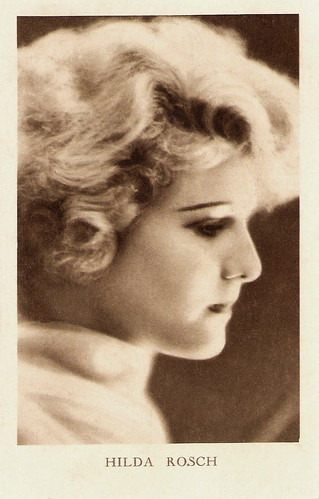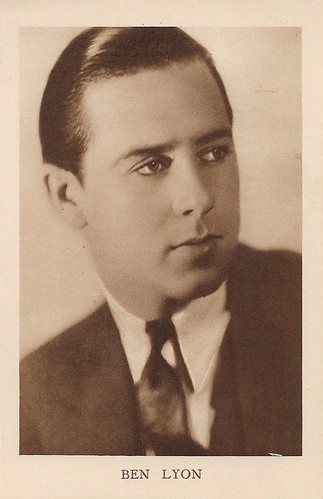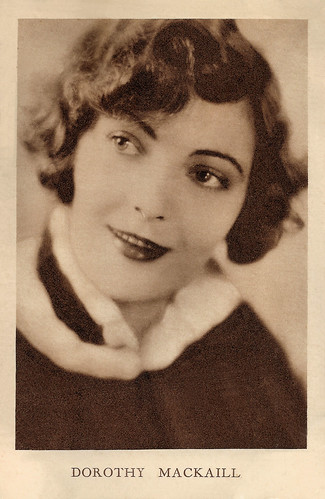The weekly issued a large series of sepia-tinted film star postcards for its readers. The postcards, published in the late 1920s, were identical to the star postcards by the Vilvorde-based chocolate factory Kivou. Yet, the Kivou cards have often (but not always) the word 'Cliché', followed by a company name on the front. Not to be confused with the quite similar cards of the Antwerp-based company N.V. Universum, which used a smaller typography. Here are our 21 favourite postcards by Weekblad Cinema.

Belgian postcard by Weekblad 'Cinema', Antwerpen. Victor McLaglen in What Price Glory (Raoul Walsh, 1926).
Victor McLaglen (1886-1959) was a Scottish boxer and World War I veteran who became a successful film actor. He started in British silent films, and later became a popular character actor in Hollywood, with a particular knack for playing drunks.

Belgian postcard by Uitgeverij Weekblad 'Cinéma', Antwerpen.
Dutch film star Truus van Aalten (1910-1999) made 29 films in the 1920s and 1930s, and only one of them in the Netherlands. The Germans lovingly called her 'die kleine holländische Käse' (the little Dutch cheese).

Belgian postcard by Ed. Weekblad Cinema, Antwerpen. French written caption: Buster Keaton, born in 1895, on the stage 24 hours after his birth, in the arms of his father.
Stone-faced Buster Keaton (1895-1966) was one of the three greatest comedians of Silent Hollywood.

Belgian postcard by Weekblad Cinema, Antwerpen.
Claude France (1893-1928) was a French silent film actress of the 1920s. Two months before her greatest triumph opened in the cinemas, she committed suicide by opening the gas.

Belgian postcard by Weekblad 'Cinema', Antwerpen. Charles Farrell in 7th Heaven (Frank Borzage, 1927).
Good-looking American actor Charles Farrell (1900-1990) was a Hollywood matinée idol of the Jazz Age and Depression era. He seems now forgotten, but between 1927 and 1934, he was very popular thanks to his teaming with Janet Gaynor in 12 screen romances, including 7th Heaven (1927), Street Angel (1928), and Lucky Star (1929). He retired from films in the early 1940s, but TV audiences of the 1950s would see him as Gale Storm's widower dad in the popular television series My Little Margie (1952-1955).

Belgian postcard by Weekblad 'Cinema', Antwerpen.
German actress Hilda Rosch only appeared in eight films between 1928 and 1931. Rosch co-starred in popular silent films with Harry Liedtke and Luciano Albertini, but she was soon forgotten.

Belgian postcard by Weekblad 'Cinema', Antwerpen.
Lucien Dalsace (1893-1980) was a French stage and screen actor who peaked in French silent cinema of the 1920s. He went from success to success in films directed by Louis Feuillade, René Leprince, Gaston Ravel, René Hervil and Henri Desfontaines.

Belgian postcard by Weekblad 'Cinema' Antwerpen.
Norma Talmadge (1894-1957) was an American actress and film producer of the silent era. She made her first films in 1910 at Vitascope. A major box-office draw for over a decade, her career peaked in the early 1920s, when she ranked among the most popular idols on the American screen.

Belgian postcard by Weekblad 'Cinema', Antwerpen.
Ben Lyon (1901- 1979) was an American stage, film, radio and TV performer, as well as a studio manager. He is famous for his part as the war aviator in Hell's Angels (1930).

Belgian postcard by Weekblad 'Cinema', Antwerpen.
Dorothy Mackaill (1903–1990) was a British-American actress, most active during the silent-film era and into the pre-Code era of the early 1930s. During the 1930s, her popularity declined and she found herself in B-movies. From 1920 to 1937, she starred in more than 60 films.

Belgian postcard by Weekblad 'Cinema', Antwerpen.
American film actor William Boyd (1895-1972) with his expressive blue eyes and prematurely silver-gray hair was a sought-after leading man of the silent movie era. He is now best known for his later parts in Westerns and is known primarily as the performer of the cowboy Hopalong Cassidy in the eponymous film and TV series.

Belgian postcard by Weekblad 'Cinema', Antwerpen.
Cute and petite American actress Sally O'Neill (1908-1968) acted in almost 50 films between the mid-1920s and the mid-1930s. Her starring role in The Brat (1931), directed by John Ford, was a highlight of her career. She also starred in several Broadway productions.

Belgian postcard by Weekblad 'Cinema', Antwerpen.
If Weimar cinema had one film star, then it was Emil Jannings (1884-1950) for sure. He was a great actor in the silent era and won the first Oscar for Best Actor. Too bad that during his later years, he worked as a board member for the Ufa propaganda machine during the Third Reich.

Belgian postcard published by Weekblad 'Cinema', Antwerpen.
Margaret Livingston (1895–1984) was an American film actress and businesswoman, most notable for her work during the silent film era. She remains best known today as 'the Woman from the City' in F.W. Murnau's film Sunrise: A Song of Two Humans (1927).

Belgian postcard by Weekblad 'Cinema', Antwerpen.
German actor Harry Liedtke (1882-1945) was the charming ladykiller of many early silent classics. Detective serials like Joe Deebs made him one of the first male stars of the German cinema.

Belgian postcard by Weekblad 'Cinema', Antwerpen.
Margaret Quimby (1904–1965) was an American stage and film actress, who appeared in both lead and supporting roles during the silent and early sound era. She is best remembered for the (lost) serial Perils of the Wild (Francis Ford, 1925) with Joe Bonomo, and such films as The Western Whirlwind (1927) with Jack Hoxie and The Tired Business Man (1927) with Raymond Hitchcock.

Belgian postcard by Weekblad 'Cinema', Antwerpen.
American comedian Charles Murray (1872-1941) appeared in 283 films between 1912 and 1938 and also directed 5 films. He worked together with George Sidney (1876-1945) on a series of comedies around the Jewish Nate Cohen and the Irish Catholic Patrick Kelly, two business partners who are constantly fighting.

Belgian postcard by Weekblad 'Cinema', Antwerpen.
American actor Richard Barthelmess (1895-1963) is best known for his roles in the films of D.W. Griffith. In 1928, he was nominated for the Academy Award for Best Actor for two films: The Patent Leather Kid and The Noose. Barthelmess made 75 films in the twenty years between his first feature in 1916 and his semi-retirement from the screen in 1936. He appeared in only six more films between 1936 and 1942.

Belgian postcard by Weekblad 'Cinema", Antwerpen.
Italian actor-acrobat Luciano Albertini (1882-1941) had a prolific career in Italian and German silent cinema. He was one of the 'Forzuti', the popular Italian strongmen and acrobats of European film in the 1910s and 1920s.

Belgian postcard by Weekblad 'Cinema', Antwerpen, 1920s.
Leatrice Joy (1893-1985) was an American actress of the silent screen. She was known for her roles as a determined and independent lady. From 1922 on, she became one of Cecil B. DeMille's favourites and protégées.

Belgian postcard by Weekblad 'Cinema', Antwerpen.
Handsome Malcolm McGregor (1892-1945) had a rich career in 1920s Hollywood as the male partner to such female stars as Pauline Frederick, Norma Shearer, Corinne Griffith and Colleen Moore. He debuted in The Prisoner of Zenda (Rex Ingram, 1922) as the dashing lieutenant who helps to defend his king. McGregor had his breakthrough as the male lead in Broken Chains (Allen Holubar, 1922) and All the Brothers Were Valiant (Irving Willat, 1923).
Source: Nathalie Hannes (De komst van de geluidsfilm in België: een nieuwe filmindustrie - Flemish).
No comments:
Post a Comment